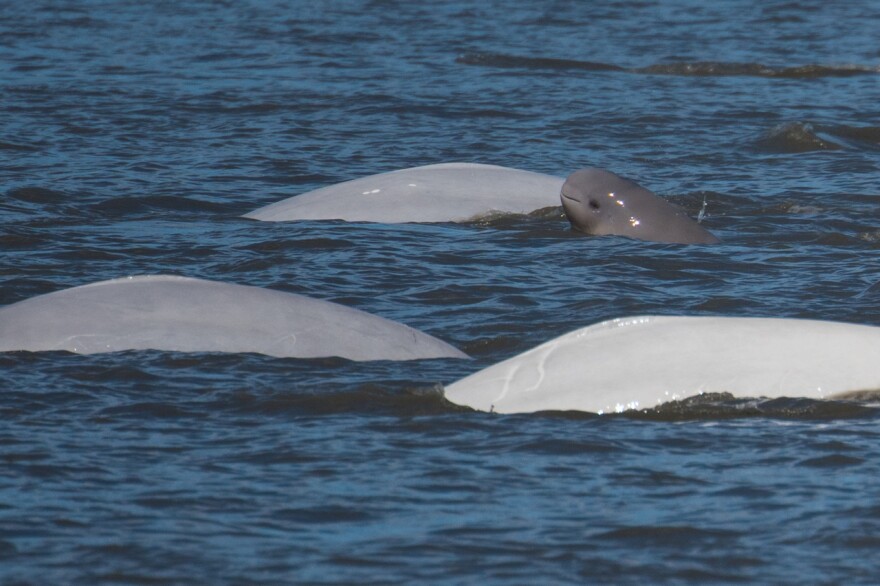The Alaska Department of Fish and Game has received a $1.1 million grant from the National Marine Fisheries Service to continue studying Cook Inlet beluga whales. The study will include more detailed information about the whales’ habitat and diet.
The Cook Inlet population of belugas is classified as endangered by the federal government. The most recent count estimated that there are about 279 of them left, which is down from the 2016 count of 328. Scientists aren’t exactly sure why the whales are declining, but the Fish and Game study is intended to help shed some more light on that question.
Dr. Lori Polasek, the the marine mammal program coordinator for Fish and Game, said one of the reasons the whales are so mysterious is because of their appearance and behavior—they don’t breach with a full tail fluke the way humpback whales do. Even if they did, the little white whales look pretty similar, which makes them hard to individually identify. On top of that, they live in a pretty difficult environment to study.
"Cook Inlet is a challenging environment," she said. "One, we all know it has these huge tidal fluxes, so getting in and out of that environment as a scientist becomes challenging. But the second is you’re working in an environment that looks like hot chocolate, is really the best way to describe it. It’s this thick, brown water that’s not transparent. I’ve seen some phenomenal studies from work on belugas in Russia, and they have this crystal clear water, and they can fly over the belugas and they can see from top to bottom, all the animal that are in that water column, and we just don’t have that luxury."
Polasek says Fish and Game has been working with the National Marine Fisheries Service to study the whales for years, and this grant will help with the continuation of that work. The study will include acoustic information gathering, focusing on how manmade sound affects the whales’ foraging environment and tracking where and what they eat. Polasek said the information could help implement the recovery plan for the whales. For instance, the federal government is interested in information about the belugas’ diet to try to decide whether the whales have maximized the resources available to them.
"Belugas are well below what would be considered potential carrying capacity, so Fish and Game is trying to provide information that would show that resources have been available and are available, and that’s not likely what caused the decline," she said. "There’s a key question for belugas, and that’s either they’re not giving birth to enough animals, or there are too many animals dying. So it’s either the birth or death question. So it’s either what’s causing mortality, too many animals dying, or what’s limiting birth."
The grant is spread across three years, through fiscal year 2022. The National Marine Fisheries Service issued five of the grants under its Species Recovery Grants to states for 2020, of which Alaska’s is the largest.
Cook Inlet is a huge place, with about 2,600 miles of shoreline. Fish and Game and the National Marine Fisheries Service have limited staff, and when a Cook Inlet beluga whale strands or washes up, they want to respond as fast as possible. Polasek says being able to reach those whale carcasses quickly is vital to research, since the scientists can only do limited work with the living whales—both because of federal rules and because they’re very shy of being touched. For instance, one the things Fish and Game is studying with the National Marine Fisheries Service grant requires the whale’s teeth. They can’t collect them from the living whales, so they rely on the carcasses that wash up.
Because NMFS does not have as much presence in Anchorage as it used to, Fish and Game is looking for funding separate from this project to help provide more responses for carcass recovery. Because Cook Inlet is so huge, she says citizen reports of both whale sightings and standings are critical to science.
"We can find out so much information," she said. "What age class died? What body condition were they in? Do they have a lot of fat, not a lot of fat? Do they have a heavy load of parasites? Are they carrying any diseases that we’re able to detect? Fish and Game is not answering all those questions, we work with National Marine Fisheries and the Sea Life Center to answer a lot of these questions."
Information about beluga whale sightings can be submitted to the Alaska Ocean Observing System’s online portal or reported to Fish and Game or the National Marine Fisheries Service.
Reach Elizabeth Earl at eearl@kdll.org.


